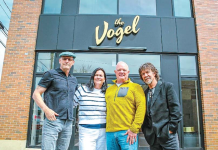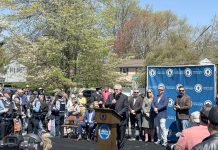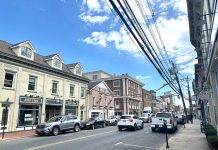
By Sunayana Prabhu
SHREWSBURY – Impassioned residents – many from a nearby active adult community – were up in arms against a developer’s proposal to replace an existing residential property with a corporate office in the borough’s historic district.
Residents packed borough council chambers at the Shrewsbury Land Use Board meeting March 1 to collectively oppose Martelli Development Group’s application seeking variance relief for 942 Broad St., locally referred to as the Judd property. Martelli has a purchase contract with the current property owner Michael Lynn.
According to borough documents, the application is part of a “bi-furcated” or two-part application to “renovate the present dwelling for commercial office use.”
The property in question is a heavily wooded 3.44- acre parcel with an existing single-family home that sits next to Mason Fields and abuts the Shrewsbury Municipal Complex and the Thornbrooke community. It is in close proximity to the historic four-way intersection at Broad Street and Sycamore Avenue which is dotted with landmarks like Christ Episcopal Church, the Quaker Meeting House, the Allen House and other Victorian homes. The speed limit on this stretch of Route 35 was recently reduced to 35 mph from 40.
Architect James Monroe and engineer Marc Leber, contracted by Martelli, presented testimony and plans showing the construction of 11 parking spaces in the rear of the building and a three-and-a-half car garage with storage which will be connected by a porch to the existing house. The house itself will be restored and renovated for commercial use.
Martelli’s attorney, Bernard Riley, assured residents and board members at the meeting that the property “won’t be a construction yard. This will be a business office with a limited number of employees basically doing contracts.”
But residents worried about traffic and environmental impacts in the historic neighborhood were not convinced. Board member Christopher Cherbini echoed many present when he questioned why the property couldn’t remain as it is currently. “Is there a problem with just redoing the house and selling the home as a single-family home?” he asked. Riley explained that the developer has done a lot of research and “to sell that house, or make it marketable and sell it” would be prohibitive.
Many also expressed concern that new infrastructure to make the building habitable for multiple employees paves the way for eventual development.
But Leber said constructing single-family homes on the property would entail a “significant burden” for the developer and, given the makeup of the property, it was “neither economical nor practical.”
The property currently falls in the R-1 single family/ PSC (Planned Senior Citizens) zone which does not allow commercial use, requiring the developer to apply for multiple zoning variances.
In addition to structural renovations, the property requires the installation of a new septic system for the “about six or seven employees in the building,” Leber said. He noted there would be no business advertising signage at the property given the historic character of the area.
According to Riley, Martelli has made several attempts to develop 942 Broad St. in the past six years, including as a medical office or office complex and for 15 townhomes. The plans lost traction due to public opposition. In consideration of public sentiments, the plan was reworked into the current proposal for a corporate office.
But public opposition for commercial use continued, with special attention given to state regulated freshwater wetlands on the property, when Leber said the area for wetlands noted on the drawing was not yet officially verified by the New Jersey Department of Environmental Protection.
“So, the board is asked to remove the restriction on the use based on data that they’re going to get later on?” asked Thornbrooke resident Mike Nugent. The borough’s zoning officer, David Crammer, said Martelli would have to repeat its use variance presentation if the NJDEP did not verify the accuracy of the engineer’s drawings.
Residents probed the experts on a number of other issues from maintaining a small commercial footprint to pedestrian traffic, construction of new sidewalks around the property, creating buffers to minimize lights on the property, traffic and stormwater management, and whether electric generators could cause additional noise pollution, among many others concerns.
The meeting ran without a break beyond the borough’s 10 p.m. scheduled end time – and some people’s bedtimes, according to one Thornbrooke resident. She jokingly called the public “cantankerous” toward the end.
Additional testimony from Martelli’s professional planner and traffic engineer will be presented at the next Land Use Board meeting scheduled for May 3.
The article originally appeared in the March 9 – 15, 2023 print edition of The Two River Times.















